Managing People and Organisations: Management Theories and Ford Motors
VerifiedAdded on 2020/05/28
|10
|2218
|70
Report
AI Summary
This report examines two key management theories: Scientific Management and the Humanistic Perspective, evaluating their impact on business growth. The report begins with an individual reflective writing piece, detailing a student's experience applying POLC (Planning, Organizing, Leading, and Controlling) skills in a group project. It then delves into the core principles of Scientific Management, as developed by Frederick Winslow Taylor, and the Humanistic Perspective, highlighting the contributions of Mary Parker Follett and Chester Barnard. A significant portion of the report analyzes how Ford Motors has applied these theories, particularly Scientific Management, to achieve success in the automotive industry. The report discusses the positive and negative aspects of each theory, providing a balanced perspective on their practical applications and implications for organizational management. The analysis includes how Henry Ford implemented these strategies to reduce production costs and make cars affordable for the masses. The report also references several academic sources to support its findings and analysis.
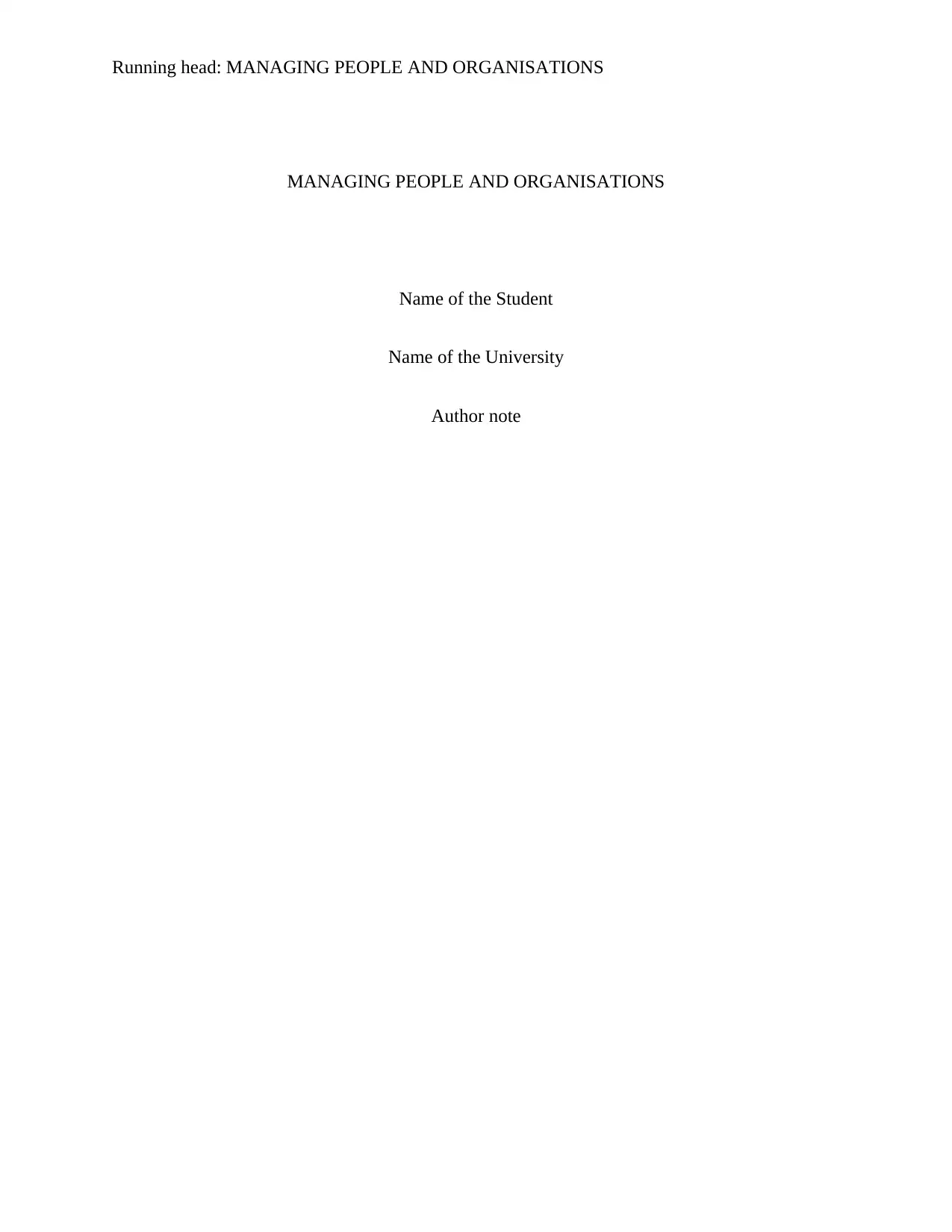
Running head: MANAGING PEOPLE AND ORGANISATIONS
MANAGING PEOPLE AND ORGANISATIONS
Name of the Student
Name of the University
Author note
MANAGING PEOPLE AND ORGANISATIONS
Name of the Student
Name of the University
Author note
Paraphrase This Document
Need a fresh take? Get an instant paraphrase of this document with our AI Paraphraser
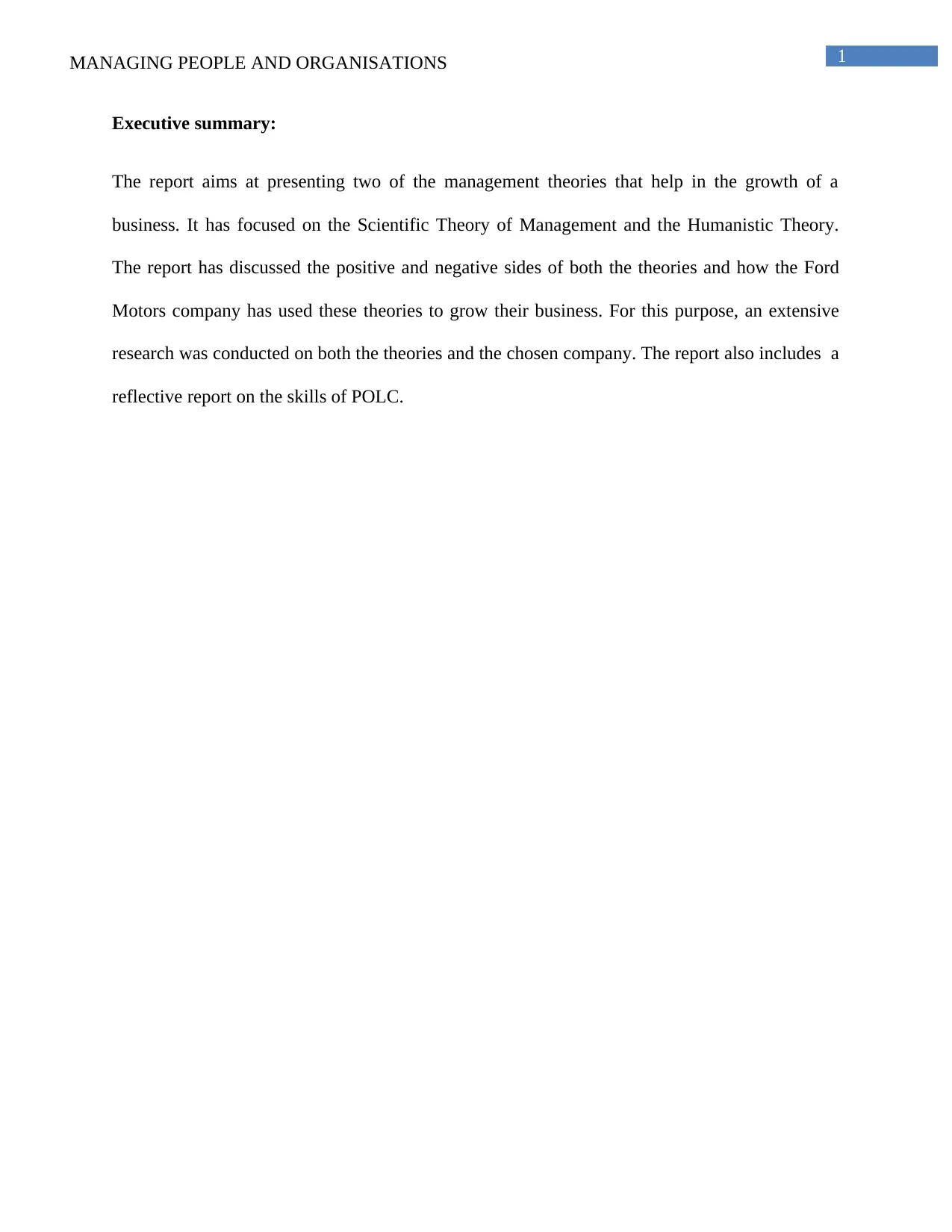
1MANAGING PEOPLE AND ORGANISATIONS
Executive summary:
The report aims at presenting two of the management theories that help in the growth of a
business. It has focused on the Scientific Theory of Management and the Humanistic Theory.
The report has discussed the positive and negative sides of both the theories and how the Ford
Motors company has used these theories to grow their business. For this purpose, an extensive
research was conducted on both the theories and the chosen company. The report also includes a
reflective report on the skills of POLC.
Executive summary:
The report aims at presenting two of the management theories that help in the growth of a
business. It has focused on the Scientific Theory of Management and the Humanistic Theory.
The report has discussed the positive and negative sides of both the theories and how the Ford
Motors company has used these theories to grow their business. For this purpose, an extensive
research was conducted on both the theories and the chosen company. The report also includes a
reflective report on the skills of POLC.
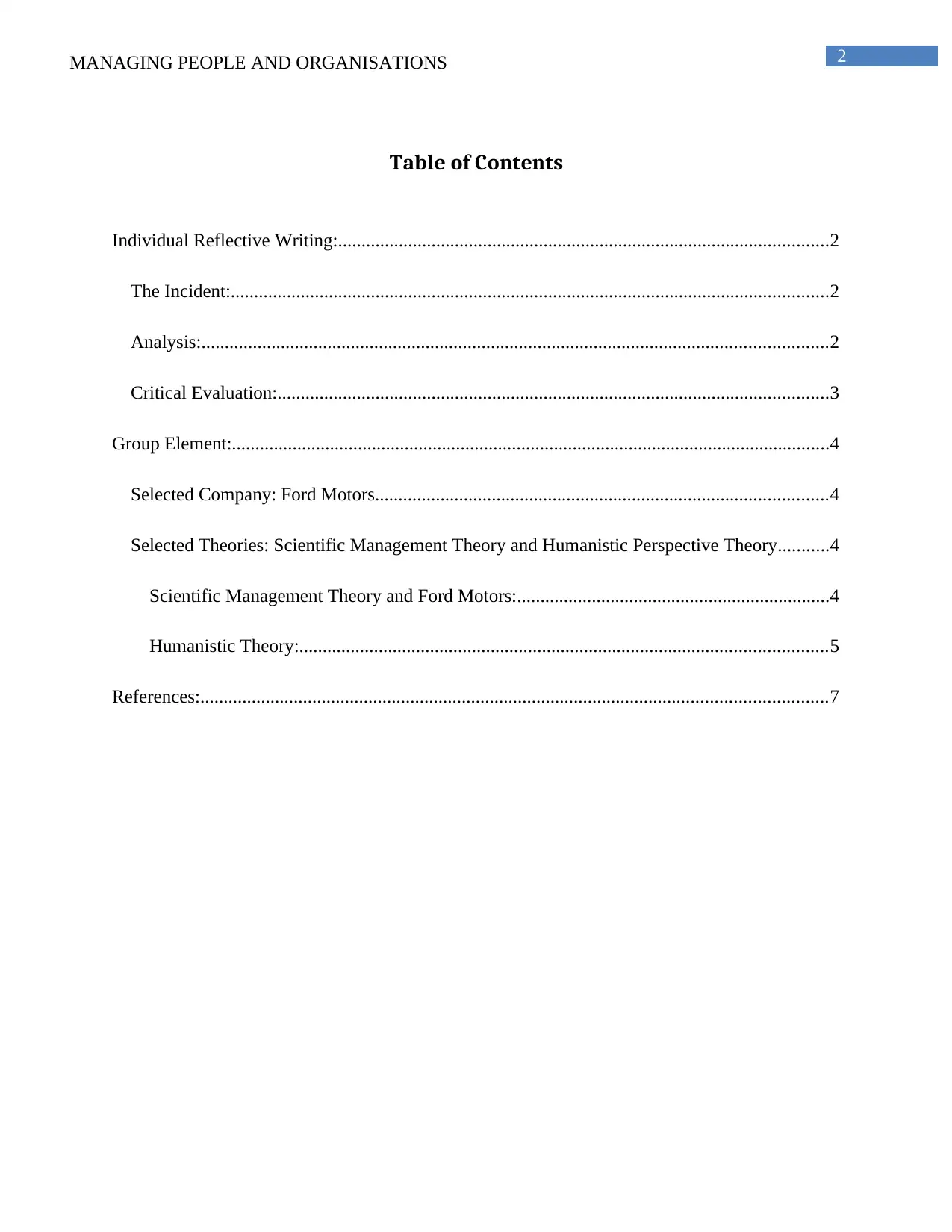
2MANAGING PEOPLE AND ORGANISATIONS
Table of Contents
Individual Reflective Writing:.........................................................................................................2
The Incident:................................................................................................................................2
Analysis:......................................................................................................................................2
Critical Evaluation:......................................................................................................................3
Group Element:................................................................................................................................4
Selected Company: Ford Motors.................................................................................................4
Selected Theories: Scientific Management Theory and Humanistic Perspective Theory...........4
Scientific Management Theory and Ford Motors:...................................................................4
Humanistic Theory:.................................................................................................................5
References:......................................................................................................................................7
Table of Contents
Individual Reflective Writing:.........................................................................................................2
The Incident:................................................................................................................................2
Analysis:......................................................................................................................................2
Critical Evaluation:......................................................................................................................3
Group Element:................................................................................................................................4
Selected Company: Ford Motors.................................................................................................4
Selected Theories: Scientific Management Theory and Humanistic Perspective Theory...........4
Scientific Management Theory and Ford Motors:...................................................................4
Humanistic Theory:.................................................................................................................5
References:......................................................................................................................................7
⊘ This is a preview!⊘
Do you want full access?
Subscribe today to unlock all pages.

Trusted by 1+ million students worldwide
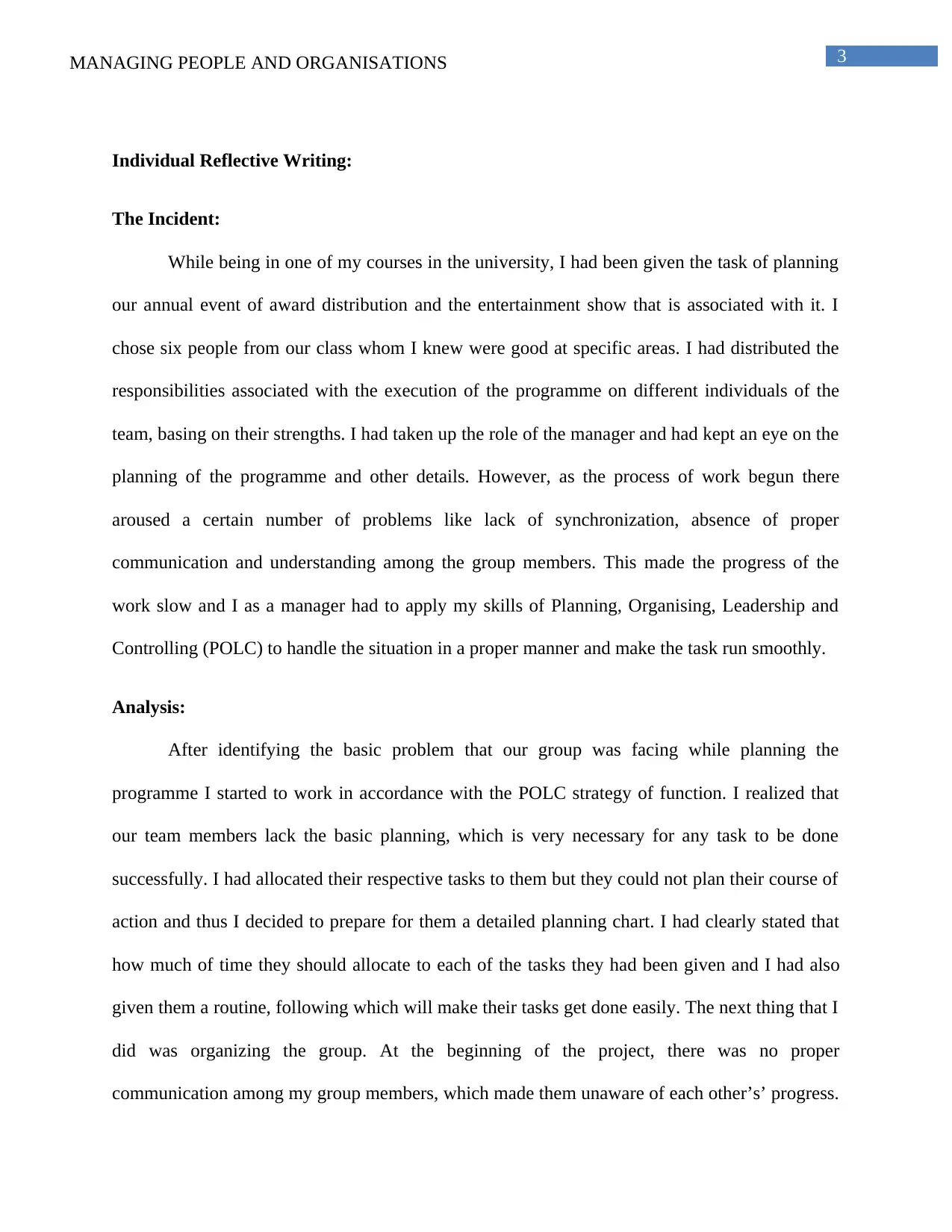
3MANAGING PEOPLE AND ORGANISATIONS
Individual Reflective Writing:
The Incident:
While being in one of my courses in the university, I had been given the task of planning
our annual event of award distribution and the entertainment show that is associated with it. I
chose six people from our class whom I knew were good at specific areas. I had distributed the
responsibilities associated with the execution of the programme on different individuals of the
team, basing on their strengths. I had taken up the role of the manager and had kept an eye on the
planning of the programme and other details. However, as the process of work begun there
aroused a certain number of problems like lack of synchronization, absence of proper
communication and understanding among the group members. This made the progress of the
work slow and I as a manager had to apply my skills of Planning, Organising, Leadership and
Controlling (POLC) to handle the situation in a proper manner and make the task run smoothly.
Analysis:
After identifying the basic problem that our group was facing while planning the
programme I started to work in accordance with the POLC strategy of function. I realized that
our team members lack the basic planning, which is very necessary for any task to be done
successfully. I had allocated their respective tasks to them but they could not plan their course of
action and thus I decided to prepare for them a detailed planning chart. I had clearly stated that
how much of time they should allocate to each of the tasks they had been given and I had also
given them a routine, following which will make their tasks get done easily. The next thing that I
did was organizing the group. At the beginning of the project, there was no proper
communication among my group members, which made them unaware of each other’s’ progress.
Individual Reflective Writing:
The Incident:
While being in one of my courses in the university, I had been given the task of planning
our annual event of award distribution and the entertainment show that is associated with it. I
chose six people from our class whom I knew were good at specific areas. I had distributed the
responsibilities associated with the execution of the programme on different individuals of the
team, basing on their strengths. I had taken up the role of the manager and had kept an eye on the
planning of the programme and other details. However, as the process of work begun there
aroused a certain number of problems like lack of synchronization, absence of proper
communication and understanding among the group members. This made the progress of the
work slow and I as a manager had to apply my skills of Planning, Organising, Leadership and
Controlling (POLC) to handle the situation in a proper manner and make the task run smoothly.
Analysis:
After identifying the basic problem that our group was facing while planning the
programme I started to work in accordance with the POLC strategy of function. I realized that
our team members lack the basic planning, which is very necessary for any task to be done
successfully. I had allocated their respective tasks to them but they could not plan their course of
action and thus I decided to prepare for them a detailed planning chart. I had clearly stated that
how much of time they should allocate to each of the tasks they had been given and I had also
given them a routine, following which will make their tasks get done easily. The next thing that I
did was organizing the group. At the beginning of the project, there was no proper
communication among my group members, which made them unaware of each other’s’ progress.
Paraphrase This Document
Need a fresh take? Get an instant paraphrase of this document with our AI Paraphraser
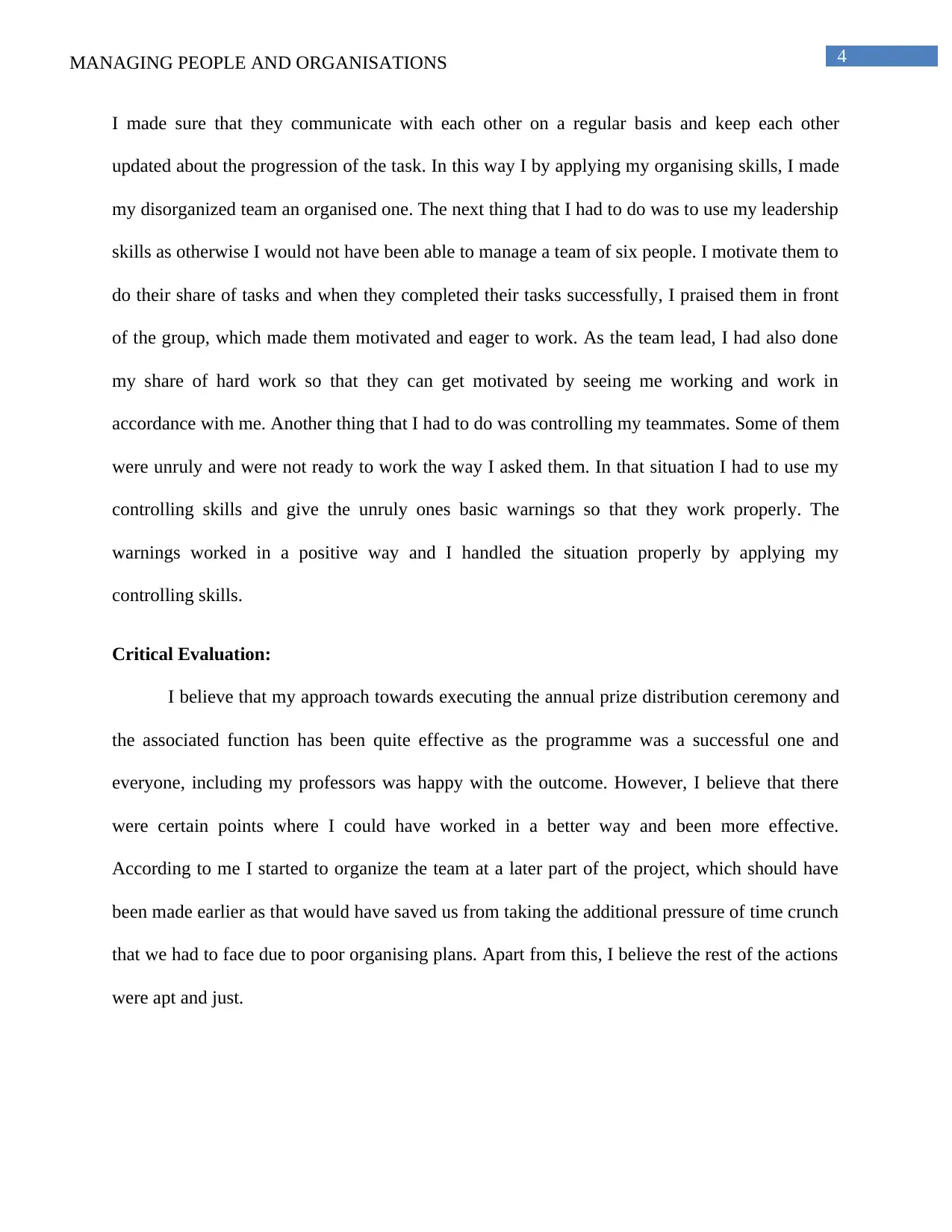
4MANAGING PEOPLE AND ORGANISATIONS
I made sure that they communicate with each other on a regular basis and keep each other
updated about the progression of the task. In this way I by applying my organising skills, I made
my disorganized team an organised one. The next thing that I had to do was to use my leadership
skills as otherwise I would not have been able to manage a team of six people. I motivate them to
do their share of tasks and when they completed their tasks successfully, I praised them in front
of the group, which made them motivated and eager to work. As the team lead, I had also done
my share of hard work so that they can get motivated by seeing me working and work in
accordance with me. Another thing that I had to do was controlling my teammates. Some of them
were unruly and were not ready to work the way I asked them. In that situation I had to use my
controlling skills and give the unruly ones basic warnings so that they work properly. The
warnings worked in a positive way and I handled the situation properly by applying my
controlling skills.
Critical Evaluation:
I believe that my approach towards executing the annual prize distribution ceremony and
the associated function has been quite effective as the programme was a successful one and
everyone, including my professors was happy with the outcome. However, I believe that there
were certain points where I could have worked in a better way and been more effective.
According to me I started to organize the team at a later part of the project, which should have
been made earlier as that would have saved us from taking the additional pressure of time crunch
that we had to face due to poor organising plans. Apart from this, I believe the rest of the actions
were apt and just.
I made sure that they communicate with each other on a regular basis and keep each other
updated about the progression of the task. In this way I by applying my organising skills, I made
my disorganized team an organised one. The next thing that I had to do was to use my leadership
skills as otherwise I would not have been able to manage a team of six people. I motivate them to
do their share of tasks and when they completed their tasks successfully, I praised them in front
of the group, which made them motivated and eager to work. As the team lead, I had also done
my share of hard work so that they can get motivated by seeing me working and work in
accordance with me. Another thing that I had to do was controlling my teammates. Some of them
were unruly and were not ready to work the way I asked them. In that situation I had to use my
controlling skills and give the unruly ones basic warnings so that they work properly. The
warnings worked in a positive way and I handled the situation properly by applying my
controlling skills.
Critical Evaluation:
I believe that my approach towards executing the annual prize distribution ceremony and
the associated function has been quite effective as the programme was a successful one and
everyone, including my professors was happy with the outcome. However, I believe that there
were certain points where I could have worked in a better way and been more effective.
According to me I started to organize the team at a later part of the project, which should have
been made earlier as that would have saved us from taking the additional pressure of time crunch
that we had to face due to poor organising plans. Apart from this, I believe the rest of the actions
were apt and just.
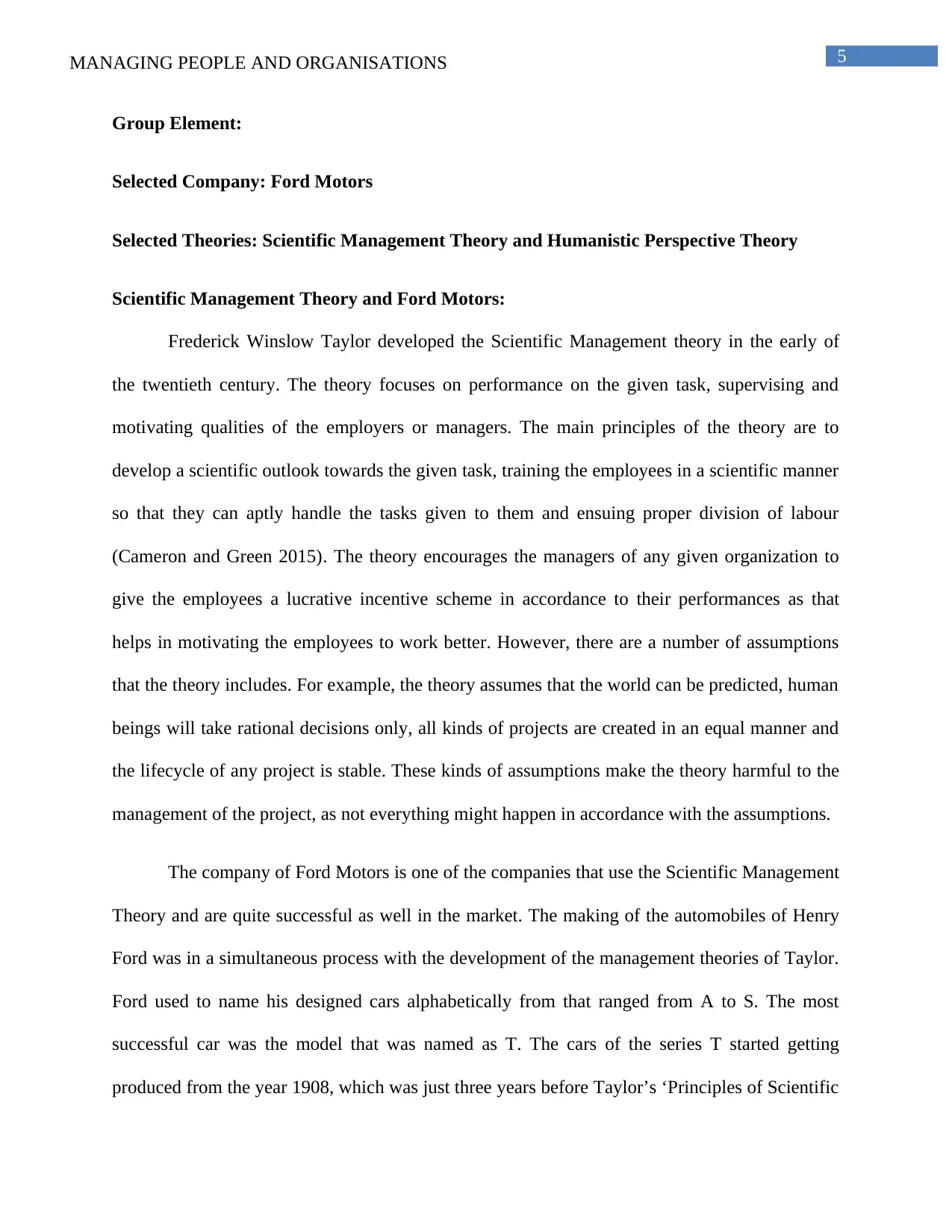
5MANAGING PEOPLE AND ORGANISATIONS
Group Element:
Selected Company: Ford Motors
Selected Theories: Scientific Management Theory and Humanistic Perspective Theory
Scientific Management Theory and Ford Motors:
Frederick Winslow Taylor developed the Scientific Management theory in the early of
the twentieth century. The theory focuses on performance on the given task, supervising and
motivating qualities of the employers or managers. The main principles of the theory are to
develop a scientific outlook towards the given task, training the employees in a scientific manner
so that they can aptly handle the tasks given to them and ensuing proper division of labour
(Cameron and Green 2015). The theory encourages the managers of any given organization to
give the employees a lucrative incentive scheme in accordance to their performances as that
helps in motivating the employees to work better. However, there are a number of assumptions
that the theory includes. For example, the theory assumes that the world can be predicted, human
beings will take rational decisions only, all kinds of projects are created in an equal manner and
the lifecycle of any project is stable. These kinds of assumptions make the theory harmful to the
management of the project, as not everything might happen in accordance with the assumptions.
The company of Ford Motors is one of the companies that use the Scientific Management
Theory and are quite successful as well in the market. The making of the automobiles of Henry
Ford was in a simultaneous process with the development of the management theories of Taylor.
Ford used to name his designed cars alphabetically from that ranged from A to S. The most
successful car was the model that was named as T. The cars of the series T started getting
produced from the year 1908, which was just three years before Taylor’s ‘Principles of Scientific
Group Element:
Selected Company: Ford Motors
Selected Theories: Scientific Management Theory and Humanistic Perspective Theory
Scientific Management Theory and Ford Motors:
Frederick Winslow Taylor developed the Scientific Management theory in the early of
the twentieth century. The theory focuses on performance on the given task, supervising and
motivating qualities of the employers or managers. The main principles of the theory are to
develop a scientific outlook towards the given task, training the employees in a scientific manner
so that they can aptly handle the tasks given to them and ensuing proper division of labour
(Cameron and Green 2015). The theory encourages the managers of any given organization to
give the employees a lucrative incentive scheme in accordance to their performances as that
helps in motivating the employees to work better. However, there are a number of assumptions
that the theory includes. For example, the theory assumes that the world can be predicted, human
beings will take rational decisions only, all kinds of projects are created in an equal manner and
the lifecycle of any project is stable. These kinds of assumptions make the theory harmful to the
management of the project, as not everything might happen in accordance with the assumptions.
The company of Ford Motors is one of the companies that use the Scientific Management
Theory and are quite successful as well in the market. The making of the automobiles of Henry
Ford was in a simultaneous process with the development of the management theories of Taylor.
Ford used to name his designed cars alphabetically from that ranged from A to S. The most
successful car was the model that was named as T. The cars of the series T started getting
produced from the year 1908, which was just three years before Taylor’s ‘Principles of Scientific
⊘ This is a preview!⊘
Do you want full access?
Subscribe today to unlock all pages.

Trusted by 1+ million students worldwide
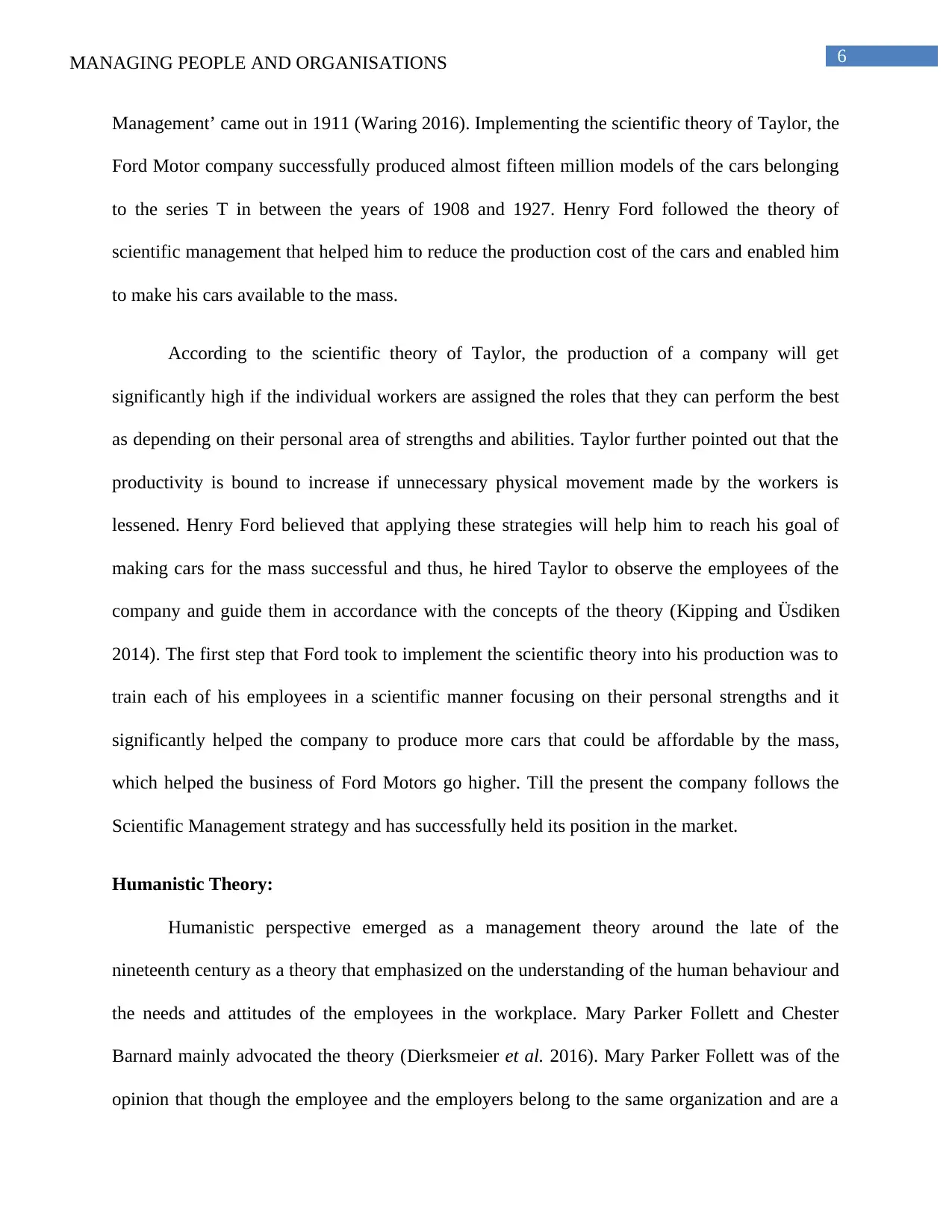
6MANAGING PEOPLE AND ORGANISATIONS
Management’ came out in 1911 (Waring 2016). Implementing the scientific theory of Taylor, the
Ford Motor company successfully produced almost fifteen million models of the cars belonging
to the series T in between the years of 1908 and 1927. Henry Ford followed the theory of
scientific management that helped him to reduce the production cost of the cars and enabled him
to make his cars available to the mass.
According to the scientific theory of Taylor, the production of a company will get
significantly high if the individual workers are assigned the roles that they can perform the best
as depending on their personal area of strengths and abilities. Taylor further pointed out that the
productivity is bound to increase if unnecessary physical movement made by the workers is
lessened. Henry Ford believed that applying these strategies will help him to reach his goal of
making cars for the mass successful and thus, he hired Taylor to observe the employees of the
company and guide them in accordance with the concepts of the theory (Kipping and Üsdiken
2014). The first step that Ford took to implement the scientific theory into his production was to
train each of his employees in a scientific manner focusing on their personal strengths and it
significantly helped the company to produce more cars that could be affordable by the mass,
which helped the business of Ford Motors go higher. Till the present the company follows the
Scientific Management strategy and has successfully held its position in the market.
Humanistic Theory:
Humanistic perspective emerged as a management theory around the late of the
nineteenth century as a theory that emphasized on the understanding of the human behaviour and
the needs and attitudes of the employees in the workplace. Mary Parker Follett and Chester
Barnard mainly advocated the theory (Dierksmeier et al. 2016). Mary Parker Follett was of the
opinion that though the employee and the employers belong to the same organization and are a
Management’ came out in 1911 (Waring 2016). Implementing the scientific theory of Taylor, the
Ford Motor company successfully produced almost fifteen million models of the cars belonging
to the series T in between the years of 1908 and 1927. Henry Ford followed the theory of
scientific management that helped him to reduce the production cost of the cars and enabled him
to make his cars available to the mass.
According to the scientific theory of Taylor, the production of a company will get
significantly high if the individual workers are assigned the roles that they can perform the best
as depending on their personal area of strengths and abilities. Taylor further pointed out that the
productivity is bound to increase if unnecessary physical movement made by the workers is
lessened. Henry Ford believed that applying these strategies will help him to reach his goal of
making cars for the mass successful and thus, he hired Taylor to observe the employees of the
company and guide them in accordance with the concepts of the theory (Kipping and Üsdiken
2014). The first step that Ford took to implement the scientific theory into his production was to
train each of his employees in a scientific manner focusing on their personal strengths and it
significantly helped the company to produce more cars that could be affordable by the mass,
which helped the business of Ford Motors go higher. Till the present the company follows the
Scientific Management strategy and has successfully held its position in the market.
Humanistic Theory:
Humanistic perspective emerged as a management theory around the late of the
nineteenth century as a theory that emphasized on the understanding of the human behaviour and
the needs and attitudes of the employees in the workplace. Mary Parker Follett and Chester
Barnard mainly advocated the theory (Dierksmeier et al. 2016). Mary Parker Follett was of the
opinion that though the employee and the employers belong to the same organization and are a
Paraphrase This Document
Need a fresh take? Get an instant paraphrase of this document with our AI Paraphraser
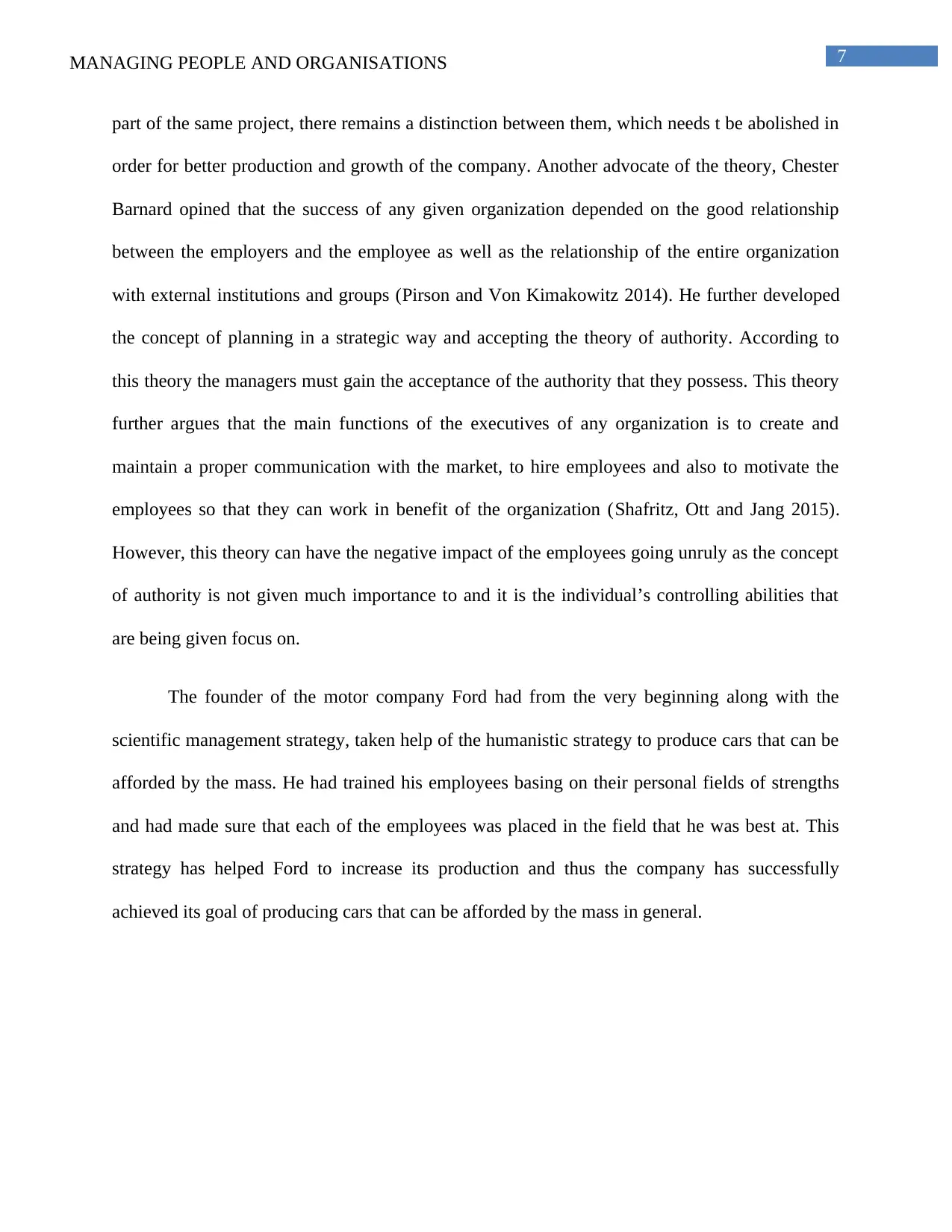
7MANAGING PEOPLE AND ORGANISATIONS
part of the same project, there remains a distinction between them, which needs t be abolished in
order for better production and growth of the company. Another advocate of the theory, Chester
Barnard opined that the success of any given organization depended on the good relationship
between the employers and the employee as well as the relationship of the entire organization
with external institutions and groups (Pirson and Von Kimakowitz 2014). He further developed
the concept of planning in a strategic way and accepting the theory of authority. According to
this theory the managers must gain the acceptance of the authority that they possess. This theory
further argues that the main functions of the executives of any organization is to create and
maintain a proper communication with the market, to hire employees and also to motivate the
employees so that they can work in benefit of the organization (Shafritz, Ott and Jang 2015).
However, this theory can have the negative impact of the employees going unruly as the concept
of authority is not given much importance to and it is the individual’s controlling abilities that
are being given focus on.
The founder of the motor company Ford had from the very beginning along with the
scientific management strategy, taken help of the humanistic strategy to produce cars that can be
afforded by the mass. He had trained his employees basing on their personal fields of strengths
and had made sure that each of the employees was placed in the field that he was best at. This
strategy has helped Ford to increase its production and thus the company has successfully
achieved its goal of producing cars that can be afforded by the mass in general.
part of the same project, there remains a distinction between them, which needs t be abolished in
order for better production and growth of the company. Another advocate of the theory, Chester
Barnard opined that the success of any given organization depended on the good relationship
between the employers and the employee as well as the relationship of the entire organization
with external institutions and groups (Pirson and Von Kimakowitz 2014). He further developed
the concept of planning in a strategic way and accepting the theory of authority. According to
this theory the managers must gain the acceptance of the authority that they possess. This theory
further argues that the main functions of the executives of any organization is to create and
maintain a proper communication with the market, to hire employees and also to motivate the
employees so that they can work in benefit of the organization (Shafritz, Ott and Jang 2015).
However, this theory can have the negative impact of the employees going unruly as the concept
of authority is not given much importance to and it is the individual’s controlling abilities that
are being given focus on.
The founder of the motor company Ford had from the very beginning along with the
scientific management strategy, taken help of the humanistic strategy to produce cars that can be
afforded by the mass. He had trained his employees basing on their personal fields of strengths
and had made sure that each of the employees was placed in the field that he was best at. This
strategy has helped Ford to increase its production and thus the company has successfully
achieved its goal of producing cars that can be afforded by the mass in general.
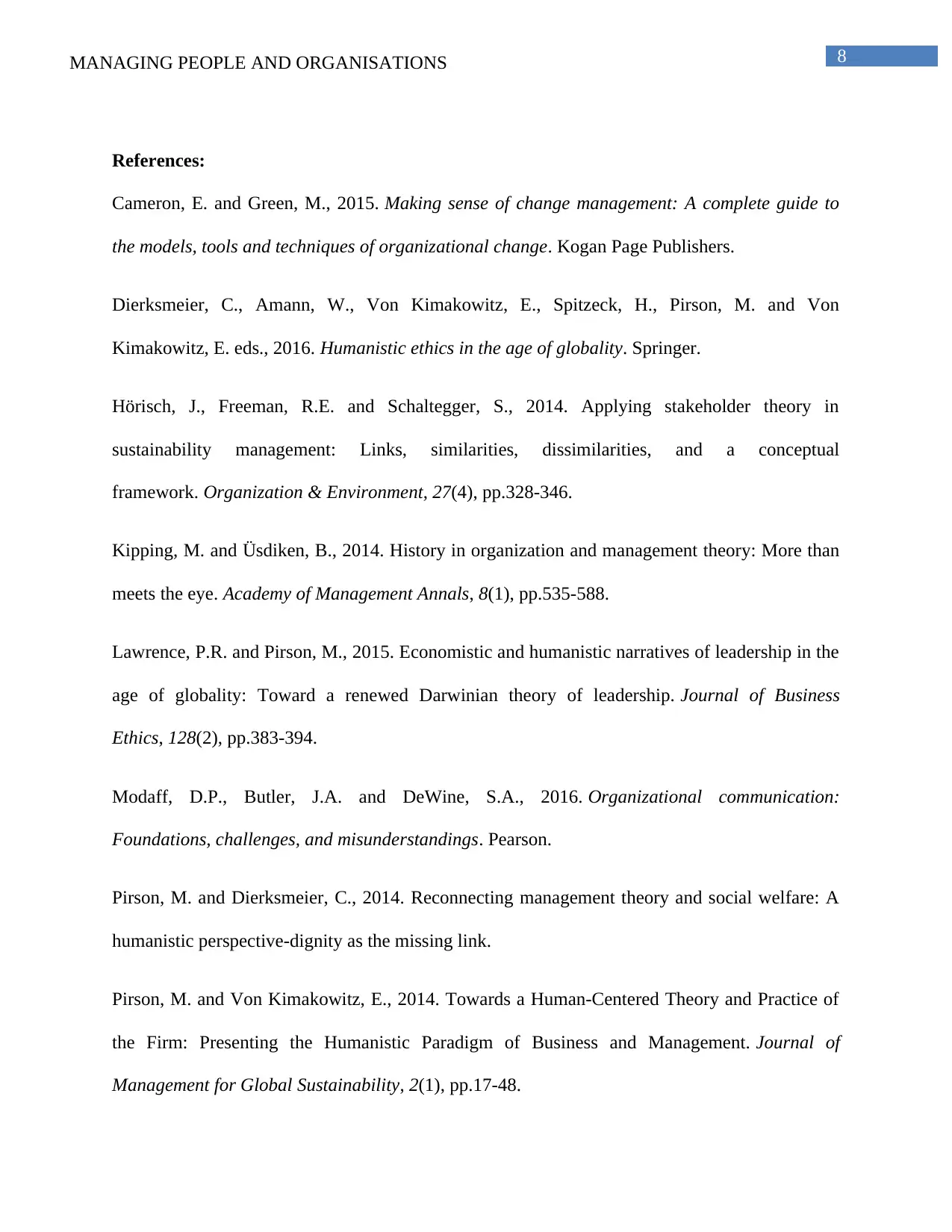
8MANAGING PEOPLE AND ORGANISATIONS
References:
Cameron, E. and Green, M., 2015. Making sense of change management: A complete guide to
the models, tools and techniques of organizational change. Kogan Page Publishers.
Dierksmeier, C., Amann, W., Von Kimakowitz, E., Spitzeck, H., Pirson, M. and Von
Kimakowitz, E. eds., 2016. Humanistic ethics in the age of globality. Springer.
Hörisch, J., Freeman, R.E. and Schaltegger, S., 2014. Applying stakeholder theory in
sustainability management: Links, similarities, dissimilarities, and a conceptual
framework. Organization & Environment, 27(4), pp.328-346.
Kipping, M. and Üsdiken, B., 2014. History in organization and management theory: More than
meets the eye. Academy of Management Annals, 8(1), pp.535-588.
Lawrence, P.R. and Pirson, M., 2015. Economistic and humanistic narratives of leadership in the
age of globality: Toward a renewed Darwinian theory of leadership. Journal of Business
Ethics, 128(2), pp.383-394.
Modaff, D.P., Butler, J.A. and DeWine, S.A., 2016. Organizational communication:
Foundations, challenges, and misunderstandings. Pearson.
Pirson, M. and Dierksmeier, C., 2014. Reconnecting management theory and social welfare: A
humanistic perspective-dignity as the missing link.
Pirson, M. and Von Kimakowitz, E., 2014. Towards a Human-Centered Theory and Practice of
the Firm: Presenting the Humanistic Paradigm of Business and Management. Journal of
Management for Global Sustainability, 2(1), pp.17-48.
References:
Cameron, E. and Green, M., 2015. Making sense of change management: A complete guide to
the models, tools and techniques of organizational change. Kogan Page Publishers.
Dierksmeier, C., Amann, W., Von Kimakowitz, E., Spitzeck, H., Pirson, M. and Von
Kimakowitz, E. eds., 2016. Humanistic ethics in the age of globality. Springer.
Hörisch, J., Freeman, R.E. and Schaltegger, S., 2014. Applying stakeholder theory in
sustainability management: Links, similarities, dissimilarities, and a conceptual
framework. Organization & Environment, 27(4), pp.328-346.
Kipping, M. and Üsdiken, B., 2014. History in organization and management theory: More than
meets the eye. Academy of Management Annals, 8(1), pp.535-588.
Lawrence, P.R. and Pirson, M., 2015. Economistic and humanistic narratives of leadership in the
age of globality: Toward a renewed Darwinian theory of leadership. Journal of Business
Ethics, 128(2), pp.383-394.
Modaff, D.P., Butler, J.A. and DeWine, S.A., 2016. Organizational communication:
Foundations, challenges, and misunderstandings. Pearson.
Pirson, M. and Dierksmeier, C., 2014. Reconnecting management theory and social welfare: A
humanistic perspective-dignity as the missing link.
Pirson, M. and Von Kimakowitz, E., 2014. Towards a Human-Centered Theory and Practice of
the Firm: Presenting the Humanistic Paradigm of Business and Management. Journal of
Management for Global Sustainability, 2(1), pp.17-48.
⊘ This is a preview!⊘
Do you want full access?
Subscribe today to unlock all pages.

Trusted by 1+ million students worldwide
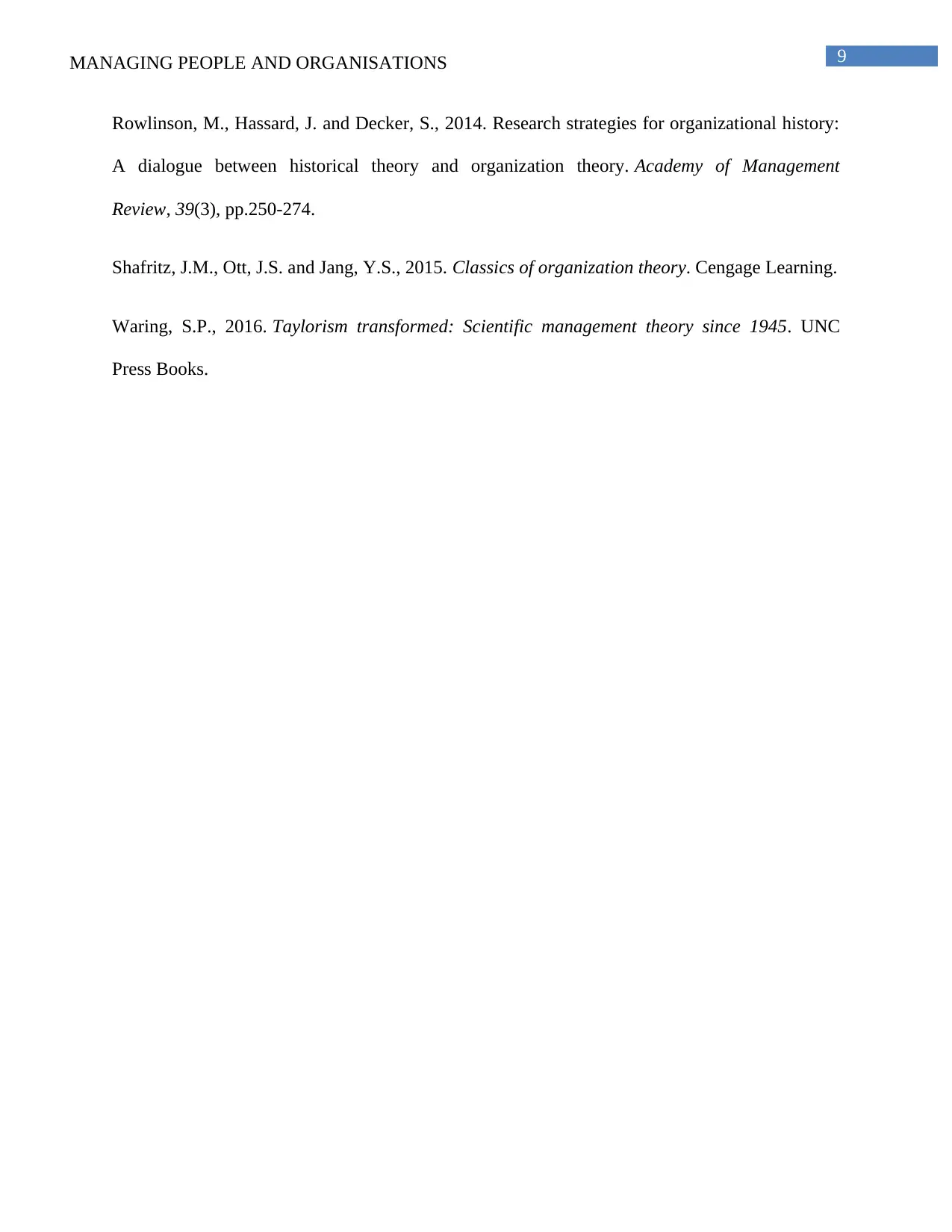
9MANAGING PEOPLE AND ORGANISATIONS
Rowlinson, M., Hassard, J. and Decker, S., 2014. Research strategies for organizational history:
A dialogue between historical theory and organization theory. Academy of Management
Review, 39(3), pp.250-274.
Shafritz, J.M., Ott, J.S. and Jang, Y.S., 2015. Classics of organization theory. Cengage Learning.
Waring, S.P., 2016. Taylorism transformed: Scientific management theory since 1945. UNC
Press Books.
Rowlinson, M., Hassard, J. and Decker, S., 2014. Research strategies for organizational history:
A dialogue between historical theory and organization theory. Academy of Management
Review, 39(3), pp.250-274.
Shafritz, J.M., Ott, J.S. and Jang, Y.S., 2015. Classics of organization theory. Cengage Learning.
Waring, S.P., 2016. Taylorism transformed: Scientific management theory since 1945. UNC
Press Books.
1 out of 10
Related Documents
Your All-in-One AI-Powered Toolkit for Academic Success.
+13062052269
info@desklib.com
Available 24*7 on WhatsApp / Email
![[object Object]](/_next/static/media/star-bottom.7253800d.svg)
Unlock your academic potential
Copyright © 2020–2025 A2Z Services. All Rights Reserved. Developed and managed by ZUCOL.




